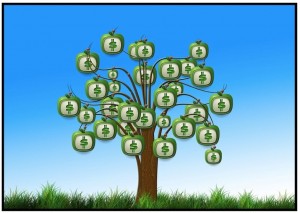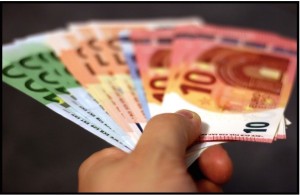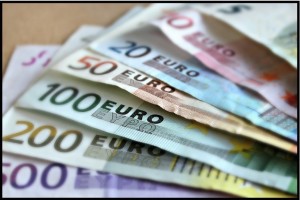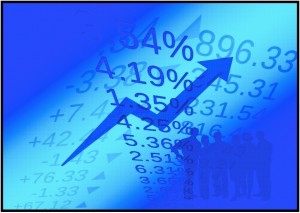Updated October 26, 2023
Futures Fundamentals and Simplifying Derivatives Investing
The history and genesis of derivatives investing trace back to commodity derivatives investing used by farmers and millers for insurance. Two or more parties actively form a derivative contract based on the underlying financial asset, security, or index, associating and determining the value. When looking further into the financial futures crystal ball, investors primarily use derivatives for speculating and hedging.
The ABC of Derivatives investing
A futures contract is a derivative, as its value is influenced by how the underlying contract performs. In the same way, stock options are derivatives investing, as their value derives from the underlying stock. The basis of profits is changing prices within the underlying asset, security, or index.
Image source: pixabay.comThe Guessing Game: Derivatives Investing and the Fine Art of Speculation
Traders can profit from the anticipated fall in the index price through sales of future contracts. This is what we call ‘going short.’
Beating the Odds: Derivatives Investing and Hedging
Derivatives investing are used as a hedge to use risks linked with the price of the underlying asset to be transferred between parties associated with a contract. Though the risk is reduced by hedging, it remains, given that prices will change. For example, in the agricultural sector, for a particular type of commodity locked in a specific price, rising rates could be due to reduced supply, which can lower the income accrued. Similarly, prices would drop, and more money would have to be paid if the supply side suddenly experiences a massive increase.
Derivative investing allows investment, permitting persons to buy or sell the security option. These are types of investments where the investor does not own the underlying asset. However, a bet is made in the direction of the price movement of an underlying asset through an agreement with another party.
Different derivative instruments, such as options, swaps, futures, and forward contracts, abound.
(Image source: pixabay.com)Derivatives investing: A Financial Language Few Understand
Derivatives investing are difficult to comprehend because they communicate in a language few can learn. Each derivative has an underlying asset on which its price, risk, and basic term structure are based. The underlying asset’s risk perception includes the derivative’s risk perception.
Pricing of derivatives may feature a strike price; this is the price at which one can exercise it. In fixed-income derivatives investing, there is also a call price at which the issuer can convert security. Investors can take different positions- long or short. A long position means purchasing the derivative, and a short position denotes you are the seller.
 (Image source: pixabay.com)
(Image source: pixabay.com)
Derivative investing has 3 primary uses in the market: hedging a position, increasing leverage, or speculating the movement of an asset. Hedging positions usually help in offering protection against the risk of an asset. If one owns shares of a stock and wants a safeguard against the possibility that stock prices will fall, the put option has to be purchased. In such a scenario, if stock prices rise, there is again as one owns shares, and if they fall, you gain because of the put option. Hedging a potential security-associated loss is done using an options position.
Leverage: The Art of Capitalizing on Derivatives Investing
Leverage can be enhanced through the use of derivatives investing. These options are most valuable when the market is at its volatile best. The movement of the option is magnified if the price of an underlying asset moves strongly in a favorable direction.
High volatility = High value of put and calls
Speculation: A Technique that Involves Betting
Through this technique, investors bet on the future price of the asset. As options offer investors the chance to leverage their position, large speculative plays can be carried out at a modest cost.
Trading: OTC versus On an Exchange
One can purchase or sell derivatives investing in dual ways—either trading over the counter (OTC) or on an exchange. OTC derivatives investing are contracts between parties on a private basis, for example, swap agreements. This market is the largest of the two and is relatively unregulated. In contrast, standardized contracts actively facilitate derivatives trading on the exchange. The largest difference between the two markets occurs in the case of OTC contracts, where counterpart risk may be associated, as the private creation of contracts actively exempts them from regulation. This derivatives investing risk is missing from exchange derivatives investing, where the clearinghouse acts as the go-between.
(Image source: pixabay.com)Derivatives Investing: Basic Types
There are three basic types of contracts: options, swaps, and forward/futures contracts. There are variations in each case. Like television has different channels, tuning in to any of these contracts will yield differential results. Options are contracts that permit but do not carry the obligation to purchase or sell an asset, thereby coming into use for those investors who do not want to risk position an asset outright and want exposure in case of large price movements in the underlying asset.
Options Trading: The Choices
- Short Call: If the stock price decreases, the call will be subject to selling or writing. If you sell the call, the buyer (long call) has control over whether or not they will exercise the option. In case you are short, you give up control as a seller. For the writer of the call, the payoff is equivalent to the premier the buyer of the call receives if there is a decline in the stock price. The writer will lose money if the stock rises more than the exercise price and the premium.
- Short Put: If the stock price is going to rise, one has to sell or write a put. For writers of the put, the payoff is equivalent to the premium the stock’s buyer receives if the price rises. When the stock price falls below the exercise price without the premium, money is lost.
- Long Call: If a stock price increases, the right (long) to buy (call) is called a long call. When the long call is held, there is a positive payoff if the stock price exceeds the exercise price by more than the premium paid for each call.
- Long Put: If the stock price decreases, the right to sell or put the stock is bought (long). Long put holders get a positive payoff if the stock price is lower than the exercise price by the premium paid for the put.
- Asian/average option: This option relates to the average value of an underlying asset for specific dates within the option’s life.
- Basket option– An option with a payoff associated with a portfolio or basket of assets.
Credit Derivative
This OTC derivative aims to transfer credit risk from one party to another. Institutions can easily manage credit risks by synthetically creating or eliminating credit exposures. Total return, credit-linked swap, and credit default actively represent three key avatars of credit derivatives investing. Whether the derivatives investing are plain vanilla or more complex and exotic, the distinction is mainly based on how different or complex the derivative is.
Derivatives Investing: Moving Beyond Cash Instruments
Derivatives investing are different from cash instruments in that they are contracts between two/more parties to convey asset ownership rather than the asset itself. They show an agreement between parties that is hugely flexible and has a starting and ending date. Investors can try derivatives investing to capture the profit from price variations within the investment. This is why derivatives investing is referred to as leveraged investments. If you employ leverage, both positive and negative results become even more significant.
Investors use price variations in underlying investments to capture profits through derivatives investing. Another reason derivatives investing is a better investment is that you can control more assets for less cash, wherein the fraction of the underlying asset’s price helps to derive profits.
Derivatives investing is also extremely flexible because anything can be an underlying asset, even the weather or the crop growth rate.
Most common derivatives investing are options, while warrants and swap contracts are others. Derivatives investing are contracts that form between buyers and sellers.
They are also known as wasting assets because of their limited shelf life. With a set expiry date, their value decreases as expiry nears. The payoff is based on the expiration date, though this is not so in all cases. As an active investor, you pay up the spot price for immediate purchase, recognizing that money may not always be exchanged at the contract’s start through cash.
(Image source: pixabay.com)Established stock exchanges such as the NYSE or Chicago Board of Trade actively trade certain derivatives investments, similar to trading underlying cash instruments. Exchange-traded derivatives investing provides clearing and regulatory safeguards for investors. Other derivative instruments, such as forwards, swaps, and exotic derivatives investing, are traded outside formal exchanges. Many large organizations work as derivatives investing dealers, customizing derivatives investing to suit the client’s needs.
Swaps: A Special Kind of Derivative
Swaps are those derivatives strategies where counterparts exchange cash flow and/or other variables linked with different investments. A swap often occurs when one party has a comparative advantage in a certain area while another can borrow more freely at fixed interest rates instead of a variable.
The Many Different Flavors of a Swap
- Plain vanilla swap is the simplest variation of this type of derivative.
- Interest rate swaps are when there is an exchange of fixed rates for floating-rate loans by parties. Consider that if one party has a fixed loan rate and floating liabilities, it may enter into a swap with a party with floating rates to match the rate to the liability. Interest rate swaps are also possible through option strategies or swaption, which gives the owner the right yet not the obligation to enter into a swap.
- Currency swaps are when a single party exchanges loan payments + principal in one currency for payments and principal in another.
- Commodity swaps are a type of contract where payment is based on the price of the commodity, which is underlying. The customer can ensure the price at which the commodity will be sold by fixing the price to be paid, similar to a futures contract.
Moving ahead, another type of contract is a forward/future contract, which forms between parties for purchasing or selling assets in the long term for a specified price. Compose such contracts based on the spot or the day’s price. The profit/loss incurred by the parties equals the difference between the spot price at the delivery time and the forward/future price. Such contracts come into use for hedging and speculating with respect to future crises.
Forwards and Futures: A Big Difference
Forwards and futures contracts differ because futures refer to standardized contracts traded on the exchange, while nonstandardized OTC contracts are forwards.
Derivatives: Deriving Value from Asset
Financial instruments like stocks, currencies, bonds, and commodities primarily have a cash-based nature. The market directly determines the value of cash instruments. In contrast, a derivative gets its value from another asset or variable, which is financial. For instance, a stock option derives its value from the stock, while an interest rate swap derives its value from an interest rate index. The asset from which the derivative is gaining traction is the underlying asset.
Benefits: The Derivative Advantage
- In the current international markets, derivatives strategies have gone from strength to strength. Derivatives can profit from transitions in interest rates and equity markets worldwide, currency exchange rate shifts, and a global demand-supply chain for commodities. So, derivatives offer investors the flexibility to trade across numerous commodities, such as agricultural products, precious and industrial metals, and products like oil.
- Derivative instruments add to the traditional investment portfolio and allow diversification, helping to hedge against inflation and inflation and returning profits far beyond traditional investments.
- Price discovery and risk management are the two main benefits of trading in derivatives. Futures markets are based on information flow worldwide, shaping current or future underlying asset prices on which derivatives strategies are based. Price discovery or constant changes in the commodity price due to information changes is a feature of derivatives trading. Within some futures markets, underlying assets can disperse geographically, and the contract price with the shortest expiration time is a proxy for underlying assets. The price of futures contracts reflects the acceptable price considering the risk associated with future price uncertainty. Options also aid in price discovery and how one can view market volatility.
- Different forms of hedging protect investors against losses. The most important purpose of the derivatives market is risk management, which involves identifying the desired risk level, identification of actual risk, and alteration of this in certain directions, thereby leading to hedging and speculation. This leads to better derivatives risk management.
- Derivatives strategies also improve market efficiency for underlying assets. Investors exploit price discrepancies by selling the expensive asset and buying the cheaper one until prices reach equilibrium. In this context, derivatives strategies create market efficiency.
- Another great advantage is that derivatives strategies also lower market transaction costs. Derivatives function as position insurance, but attractive proposition depends on reasonable premiums (investment costs) associated with them. They can protect against significant business exposure regarding the movement in asset price, interest or exchange rate, or creditor default.
- Derivatives contribute to the flow of capital or raise credit availability in the economy. They also enable businesses to manage effective exposure to external influences on business over which there is no control.
Risks: The Darker Side of Derivatives
Lack of transparency is a key risk in the derivatives market, especially in the OTC scenario. The OTC market can blindside market participants and regulators. A lack of awareness of overall market positions can also reduce market liquidity. Contractual obligations raise an additional concern in investment as they create counterparty risk until they are met. For example, if there is a failure to supply goods or services in a futures contract, the counter-party can have a downside.
Both systemic and operational risks impact derivatives contracts. Operational risks result from a lack of control systems or human errors. Systemic risk pertains to the risk faced by the derivatives financial system due to a default by a significant player in the derivatives market. Default in corner A of the world can have massive implications for the entire globe, another risky offshoot of the derivatives market. Credit default swaps are opaque and complex, making it difficult for people to understand risk in the complete sense of the term.
Conclusion
(Image source: pixabay.com)What goes up must come down, but the same is not always true for the derivatives investing market. Thanks to the derivatives investing market, the exciting world of futures trading involves high stakes. Playing for higher stakes means greater profits in the world of derivatives investing. Dealing in derivatives investing is an art and a science. The business of derivatives investing makes the economy vibrant, too. Not without its risks, the derivatives investing market is as multifaceted and far-reaching in its influence as the high stakes it involves.
Recommended Articles
Here are some further articles to learn more:










